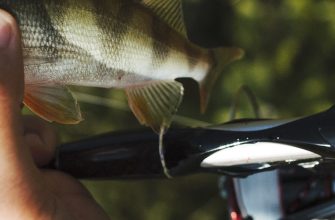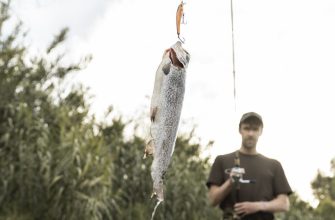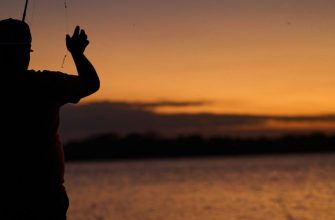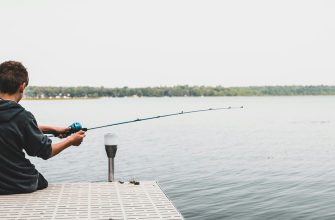- Introduction to North Georgia Fly Fishing
- Overview of North Georgia Fisheries
- The Allure of the Toccoa River
- Understanding the Toccoa River
- Geography of the Toccoa River
- Upper Toccoa River
- Lower Toccoa River’s Tailwaters
- Tributaries of Toccoa River
- Catch-and-Release Designated Areas
- Toccoa River Fish Species
- Rainbow Trout
- Brown Trout
- Brook Trout
- Other Fish Species
- Toccoa River Seasons for Trout Fishing
- Trophy Spots Along the Toccoa River
- Toccoa River “Deferred Harvest” section/upper Toccoa River
- Tailwater below Blue Ridge Dam/Lower Toccoa River
- Tammen Park: A Hidden Gem
- Noontootla Creek
- Rock Creek
- Cooper Creek
- Secluded Spots Along the Toccoa River
- Getting Started with Fly Fishing on the Toccoa River
- Basic Tackle for Fly Fishing
- Step-by-Step Instructions for Getting Started Fly Fishing for Trout
- Trout Fly Fishing in the Upper Section of Toccoa River
- Rainbow Trout Hooking
- Brook Trout Catching
- Brown Trout Fishing
- Toccoa River Upper Section Float Trips
- Trout Fly Fishing in the Tailwater Section of Toccoa River
- Species of Trout
- Peculiarities of Fly Fishing in This Section
- Best Flies
- Wading the River Tailwaters
- Float Trips on the Toccoa River Tailwater
- Streamer Fishing the Toccoa River for Trophy Trout
- What is the Streamer Fishing?
- Choosing the Right Streamer
- Best Times for Fishing
- Techniques for Successful Fishing
- Planning Your Toccoa River Fly Fishing Trip
- Setting Up a Float Journey on the Toccoa River
- Local Regulations and Fishing Etiquette
- FAQs
- Q: What are some popular fly patterns for trout fishing on the Toccoa River?
- Q: Where can I find stocked trout in the Toccoa River?
- Q: Can I find wild trout in the Toccoa River?
- Q: What are the regulations for fishing on the Toccoa River?
- Q: Are there opportunities for wade fishing on the Toccoa River?
- Q: Where is the best public access for trout fishing on the Toccoa River?
- Q: What other fish species can be found in the Toccoa River?
- Q: How can I get the best fishing experience on the Toccoa River?
- Q: What are the best areas for trout fishing on the Toccoa River?
- Q: What are the best times of day for trout fishing on the Toccoa River?
Welcome to the serene world of fly fishing in the beautiful Toccoa River. Nestled in the heart of the North Georgia Mountains, our journey begins where the Toccoa River does, in the Chattahoochee National Forest. This river, a gem within the wildlife-rich forests, offers a unique experience for every angler seeking a tranquil retreat.
The river’s depth varies, offering a delightful mix of deep holes, sandy bottoms, and riffles that house the big trout. A day spent here is a day spent in solitude, immersing in the enchanting orchestra of wildlife nature.
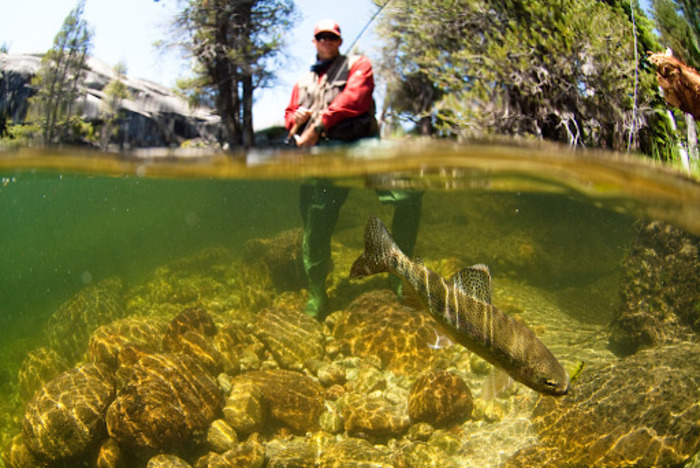
Toccoa River begins its journey in Union County, Georgia, then flows through Fannin, and Gilmer counties and joins the Ocoee River in Stevens County of the same state.
A full day spent casting your line here, amid the untouched public land, is a day well spent. However, anglers must remember, the treasure of catching a big trout comes with the responsibility of preserving this natural wonder for future generations.
So, pack your gear and head to the Toccoa River – a paradisiacal escape nestled in the wilderness, that promises an unforgettable fly fishing experience.
Introduction to North Georgia Fly Fishing

Overview of North Georgia Fisheries
North Georgia is home to a diverse range of fisheries, making it a paradise for anglers. Its pristine streams, rivers, and lakes are teeming with various species of trout, including rainbow, brown, and brook trout. These water bodies offer both cold water and warm water fishing opportunities, catering to every angler’s preference.
The state’s topography, coupled with its temperate climate, creates an ideal environment for these fish to thrive. The mountain streams, in particular, offer some of the best trout fishing spots in the country. The quality of these fisheries is maintained through careful management, ensuring that they continue to provide excellent fishing opportunities for generations to come.
The Allure of the Toccoa River
The Toccoa River stands as one of the crown jewels amongst North Georgia fisheries. Its crystal-clear waters, scenic surroundings, and abundant trout population make it a favorite destination for fly fishing enthusiasts.
The river is divided into two primary sections for anglers – the Upper Toccoa and the Toccoa Tailwaters.
Understanding the Toccoa River
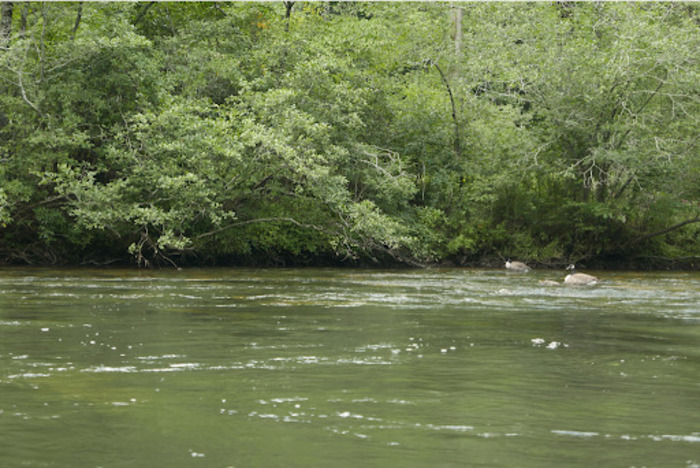
Geography of the Toccoa River
The Toccoa River originates in Union County, Georgia, in the northeastern part of the state. It is approximately 88 kilometers long. It flows out of Blue Ridge Reservoir, which is formed by Blue Ridge Dam on Lake Blue Ridge
The Toccoa River then flows in a predominantly north and northwest direction through Fannin and Gilmer counties. It then enters Stevens County, where the river is home to the scenic 60-foot-high Toccoa Falls.
The Toccoa River ends in Stevens County, Georgia, where it merges with the Ocoee River to form the Hiwassee River.
Upper Toccoa River
The Upper Toccoa is situated in Union and Fannin Counties. It includes the stretch of river from the origin at the Blue Ridge Reservoir upstream to the town of McCaysville.
This is the mountainous portion of the Toccoa River, which flows through forests and farmlands in the foothills of the Blue Ridge Mountains range of the Appalachians. The river channel here is winding, the currents swift, with many riffles.
Read more: Best Trout Fishing in the US 2024 – Best Trout Streams & Rivers to Catch Trout
So the headwaters of the Toccoa constitute a classic mountain river, cascading down from the Appalachian highlands in Georgia before reaching the valley around McCaysville. It’s a picturesque, popular section for anglers.
The Upper Toccoa winds through remote terrain, descending over shoals and small falls. The cold, rushing currents provide an ideal habitat for rainbow and brown trout eagerly sought after by fly fishers. It’s a treasured destination for those seeking beautiful scenery and lively fishing.
Lower Toccoa River’s Tailwaters
The Lower Toccoa River’s Tailwaters refer to the lower section of the Toccoa River as it flows through the lowlands.
Specifically, the Lower Toccoa River’s Tailwaters designate approximately the last 16 kilometers of the Toccoa River, from Toccoa Dam down to the confluence with the Ocoee River. So it represents the transitional stretch from the dam to the merger point with the Ocoee.
Geographically, the Lower Toccoa Tailwaters are located in Stephens County, Georgia, just east of the small town of Toccoa.
So this is essentially the final leg of the Toccoa before it meets up with the Ocoee River and forms the Hiwassee River in eastern Georgia, near the Tennessee state border.
It transitions from a deeper river to riffles and shoals as it approaches the Ocoee. The Tailwaters provide high-quality trout habitat as cold waters from the dam mix with the warmer Ocoee river waters. It’s a popular fishing destination in North Georgia.
Tributaries of Toccoa River
The Toccoa River’s tributaries, such as Rock Creek and Cooper Creek, offer excellent fishing opportunities. These streams, teeming with wild trout, offer a serene setting for anglers looking for a more secluded fishing experience.
Catch-and-Release Designated Areas
Certain sections of the Toccoa River are designated as catch-and-release areas to protect the trout population. These areas, specifically managed for trout conservation, ensure the sustainability of the fishery. As responsible anglers, it’s crucial to respect these designations and practice catch-and-release to preserve the river’s trout populations for future generations.
Toccoa River Fish Species
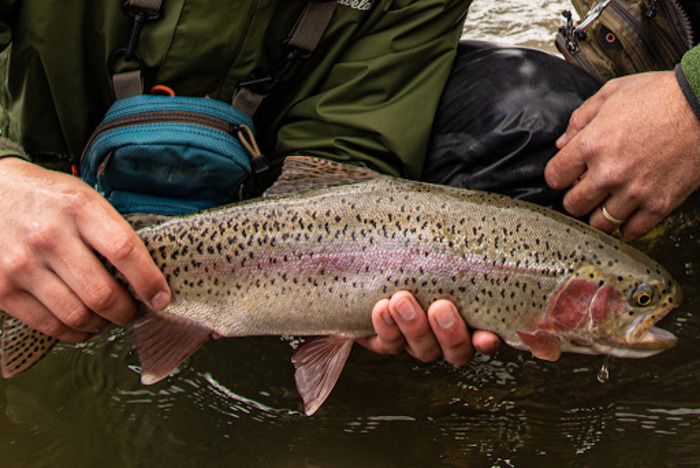
Rainbow Trout
Rainbow trout in the Toccoa River are an angler’s delight. These vibrant fish are known for their acrobatic leaps and strong fights, making every catch an unforgettable experience.
Brown Trout
The river’s brown trout are equally rewarding to catch. Known for their elusive nature and larger sizes, these fish present an exciting challenge for those seeking a more demanding fishing experience.
Brook Trout
The brook trout, while less common, can also be found in the Toccoa River. These fish are smaller than the rainbow and brown trout, but their beautiful markings and spirited fights make them a favorite among anglers.
Other Fish Species
Of course, the Toccoa River is home to more than just trout. Anglers may also encounter bass, catfish, and other species, adding to the diversity and appeal of this remarkable fishing destination.
Toccoa River Seasons for Trout Fishing
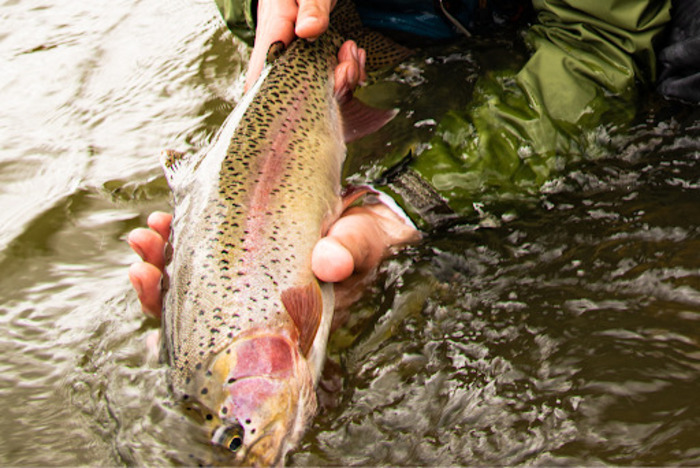
Fishing enthusiasts know that timing is everything, and the Toccoa River is no exception. When it comes to trout angling, certain seasons can significantly enhance your experience and success rate. Here, we’ll delve into the optimal times for trout angling on the Toccoa River.
In general, the best time to angle for trout in this river is during the cooler months of the year. The river’s water temperature is perfect for trout from late fall through early spring, making these seasons prime for anglers.
The late fall, particularly November, is an excellent time as trout begin their spawning season. This period sees an increase in fish activity, providing an exciting opportunity for anglers. The water levels are also usually favorable, thanks to the autumn rains.
Winter, despite the colder weather, can also be a great season for trout angling on the Toccoa River. The trout are still active during this time, and the less crowded river offers a serene and peaceful fishing experience.
In the early spring, especially March and April, the trout are often found in abundance. They are coming out of their winter lethargy and starting to feed more aggressively, making it an ideal time to cast your line.
However, keep in mind that the summer can be challenging for trout angling on the Toccoa River. The warmer water temperatures can make the trout less active, especially during the hottest parts of the day. It’s better to aim for early morning or late evening during these warmer months.
Lastly, remember that local weather conditions can significantly affect fish behavior. It’s always a good idea to check the local weather and water conditions before you head out for your angling adventure.
Trophy Spots Along the Toccoa River
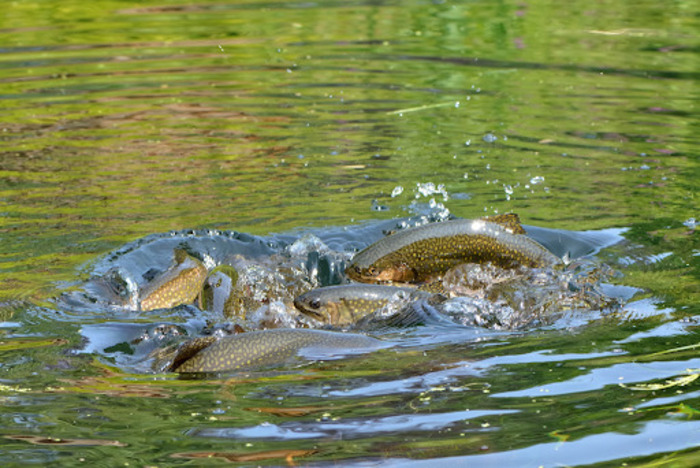
Toccoa River “Deferred Harvest” section/upper Toccoa River
The Deferred Harvest section is a 1.5-mile stretch of the river that has special fishing regulations to protect its delicate ecosystem.
The Georgia Department of Natural Resources stocks rainbow, brown and brook trout here from November through May. Regulations state that only catch-and-release trout fishing is allowed in this area from November through May 14.
This results in a spike in trout numbers and makes this stretch of river a great place for anyone looking to catch larger fish.
Please note that this is a catch-and-release site and the use of natural bait is prohibited.
Tailwater below Blue Ridge Dam/Lower Toccoa River
The expanse below the Blue Ridge Dam, also known as the Lower Toccoa, is another prime location for angling enthusiasts. The dam release provides a cool, constant water temperature, making it an ideal habitat for trout.
The waters are abundant with substantial Brown and Rainbow trout, making it a beloved spot for fly-fishers. If you’re planning a visit, make sure to check the dam’s water release schedule for safety.
Tammen Park: A Hidden Gem
Situated just below the Blue Ridge Dam, Tammen Park is a must-visit for any fishing enthusiast. This park offers easy access to the river and a variety of trout species, providing an ideal setting for a peaceful day of fishing.
Noontootla Creek
Noontootla Creek is a tributary of the Toccoa and is a haven for wild trout. This creek is more challenging due to its small size and wild fish, but it’s worth a visit. The rewards are high – the creek is known for its sizeable wild Rainbow and Brown trout. Keep in mind that this area is catch and release, and only artificial lures are allowed.
Rock Creek
Rock Creek is a small, serene tributary of the Toccoa River. It’s a tranquil spot that offers a peaceful fishing experience. The creek is surrounded by lush greenery, making it a picturesque spot for fishing. Despite its small size, Rock Creek is well-stocked with fish, making it a popular choice among locals.
Cooper Creek
Cooper Creek is another tributary of the Toccoa River that offers excellent fishing opportunities. The creek is known for its clear waters and abundant fish. It’s a great spot for beginners to learn the ropes and for experienced anglers to hone their skills.
Secluded Spots Along the Toccoa River
If you’re looking for a more secluded fishing experience, the Toccoa River has plenty to offer. Numerous spots along the river are off the beaten path, providing a peaceful and serene environment for fishing.
Getting Started with Fly Fishing on the Toccoa River
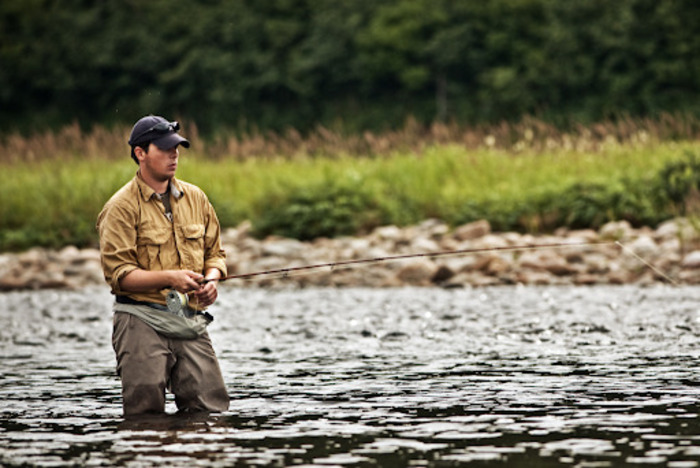
Basic Tackle for Fly Fishing
Firstly, a fly rod of around 8.5 to 9 feet in length is recommended. This length provides a good balance between casting ability and control. A 5-weight line is also a good all-around choice for this location.
In terms of flies, nymphs and dry flies are both effective in the Toccoa. Popular nymph choices include the Pheasant Tail, Hare’s Ear, and Zebra Midge. For dry flies, consider the Adams or Elk Hair Caddis. Remember, the fish in this area are known for their wariness, so presentation is key.
Step-by-Step Instructions for Getting Started Fly Fishing for Trout
- Research and Planning: Before visiting, it’s important to understand the conditions and rules of the area. Familiarize yourself with local regulations and the best times to fish. Early spring and late fall are often the prime times.
- Assemble Your Gear: Prepare your rod, reel, line, and flies. Remember to include essentials like waders, a fishing vest, a hat, and polarized sunglasses for eye protection and better visibility in the water.
- Arrive Early: Arrive at your chosen location early in the morning. The best fishing spots can get crowded, so being early ensures you have your pick.
- Observe the Water: Take a moment to watch the water. Look for signs of fish activity, such as jumping fish or swirling water.
- Start Fishing: Start by casting upstream and let your fly drift downstream naturally. Remember, presentation is key. The fish in Toccoa are known to be picky, so a natural and accurate presentation of your fly is important.
- Practice Catch and Release: To preserve the fish population in the river, it’s encouraged to practice catch and release. Gently remove the hook and release the fish back into the water as quickly as possible.
Trout Fly Fishing in the Upper Section of Toccoa River
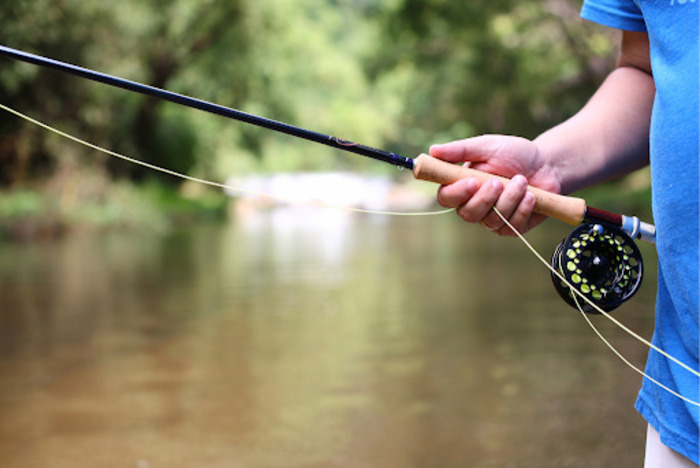
Rainbow Trout Hooking
When fishing for rainbows, it’s important to consider the time of day, as these fish are known to be most active during the early morning and late afternoon. A tried and true method is using the nymph technique, which involves presenting the fly beneath the water surface.
Patience is key here: let the nymph drift naturally with the current, and wait for the trout to strike.
Brook Trout Catching
Brook trout, with their distinctive marbled pattern, are a sight to behold in the river’s clear waters. They prefer cooler water temperatures, so fishing in shaded areas or during cooler times of the day can prove successful.
When it comes to bait, consider using dry flies. The technique here is to mimic the natural movement of the fly, making it irresistible to the brook trout below.
Brown Trout Fishing
Brown trout are known for being elusive, making the catch all the more rewarding. They are more active during dawn and dusk, so plan your fishing trip accordingly.
Unlike the other species, brown trout are not easily fooled by dry flies or nymphs. In this case, using streamers can be an effective approach. Remember, brown trout are smart, so try to vary your casting and retrieval techniques to outwit them.
Toccoa River Upper Section Float Trips
Lastly, for an unforgettable fishing experience, consider a float trip on the upper section of the river. This gives you access to areas that are otherwise difficult to reach, increasing your chances of a successful catch.
In addition, the trip itself is a serene experience, allowing you to enjoy the beautiful landscapes that surround the river. Remember, fishing is not just about the catch, but also about enjoying nature and the whole experience.
Trout Fly Fishing in the Tailwater Section of Toccoa River

Species of Trout
The Toccoa River is home to a diverse array of trout species. The tailwater section, located below the Blue Ridge Dam, is known for its healthy population of rainbow trout. These vibrant fish are a thrill to catch and offer a challenging endeavor for the dedicated angler.
Peculiarities of Fly Fishing in This Section
Fly fishing in the tailwater section of the Toccoa River presents a unique experience. The river’s flow is controlled by the dam, resulting in variable water levels. Anglers need to be mindful of these changes, as they can affect the fish’s feeding patterns and location. Also, the tailwater section of the river is known for its deep pools and runs, providing excellent habitat for trout.
Best Flies
When it comes to fly choice, patterns such as the pheasant tail nymph and the zebra midge have proven effective. However, it’s always a good idea to check with local fly shops for the most up-to-date information on what’s working best. Conditions can change rapidly, and what works one day might not necessarily work the next.
Wading the River Tailwaters
Wading the Toccoa River tailwaters can be a rewarding experience. However, anglers need to be prepared for the river’s changing conditions. The dam often releases water, which can quickly increase the water level and current. Always be aware of your surroundings, and if you’re new to the area, consider hiring a local guide to help you navigate the river safely.
Float Trips on the Toccoa River Tailwater
For those who prefer a more relaxed approach, float trips are a popular way to explore the Toccoa River tailwater. These trips allow you to cover more water and access areas that are difficult to reach by foot. Float trips are also a great way to enjoy the beautiful scenery of the river and its surroundings. As always, safety is paramount, so ensure your vessel is suitable for the river’s conditions, and wear a life jacket at all times.
Streamer Fishing the Toccoa River for Trophy Trout
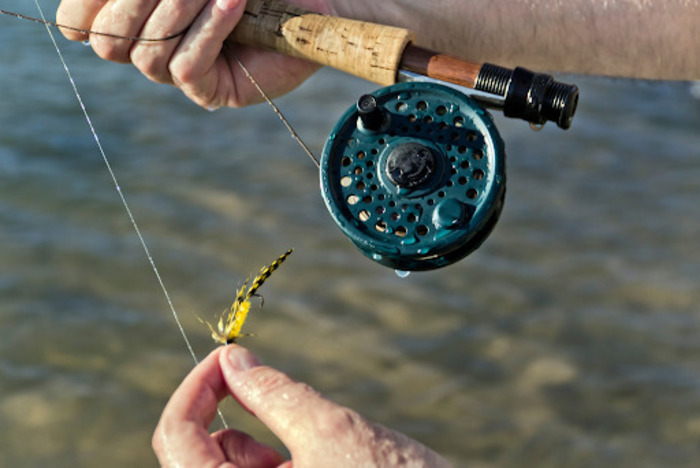
What is the Streamer Fishing?
It is a method of catching trout and other predatory fish using artificial lures that imitate baitfish or other natural prey items. The main idea behind streamer fishing is to fool the fish into mistaking an artificial fly for real prey.
In this fishing technique, specialized lures called streamers are used. They are imitations of minnows, frogs, mice, and other trout foods. These attractants are made out of fur, feathers, silicone, and plastic.
Choosing the Right Streamer
Choosing the right attractant is the first step. The choice of streamer can vary depending on the season and the water conditions. Larger attractants can be very effective as they mimic the larger prey of the trout in the Toccoa River. However, it is important to have a range of these attractants in your tackle box, so you can switch if one isn’t working.
There are many different streamer patterns used for trout, often trying to match the specific forage fish or other prey found in a given body of water. Here are some recommended attractant types for targeting trout in North Georgia’s Toccoa River:
- Woolly Buggers – These are versatile attractants that well imitate baitfish. You can use them in different colors and sizes based on the available food sources. Black, olive, and brown buggers are often productive.
- Minnow imitations – such as zonkers, julies, and basic minnow patterns. They should feature bright colors to match local minnow species. White and yellow work well in stained water.
- Sculpin imitations – trout in the Toccoa River system actively feed on sculpins. Patterns with a broad head and undulating tail are very enticing to them.
- Flies with marabou or deer hair tails which give them a pulsing action in the water. This triggers the predatory reaction of trout well.
Experiment with different colors and sizes until you discover what the trout prefers on a given day or spot on the river.
Best Times for Fishing
Streamer fishing can be productive at any time of the year. However, it is generally most effective during the early morning and late evening hours when trout are most active. The Toccoa River in particular, located in the lush landscape of North Georgia, offers many prime fishing spots that are active during these times.
It is important to note that weather conditions also play a key role in fishing. Overcast days can be particularly good for fishing as trout are more likely to be feeding.
Techniques for Successful Fishing
Streamer fishing requires different techniques compared to other forms of fly fishing. The goal is to match the hatch by mimicking baitfish patterns on that section of the Toccoa.
One of the most effective techniques is the “swing” technique. The angler casts the streamer upstream and allows it to drift downstream in the current, mimicking the behavior of live prey. As it drifts, they impart lifelike wigging motions using the rod tip. This triggers aggressive strikes from predatory fish.
Another effective technique is to vary the speed of your retrieve. Sometimes, a slow and steady retrieve can be more effective, while at other times, a quicker retrieve might yield better results.
Use sinking leaders and varying retrieves until you find what triggers savage strikes from trout lying in wait within the river structure.
Planning Your Toccoa River Fly Fishing Trip
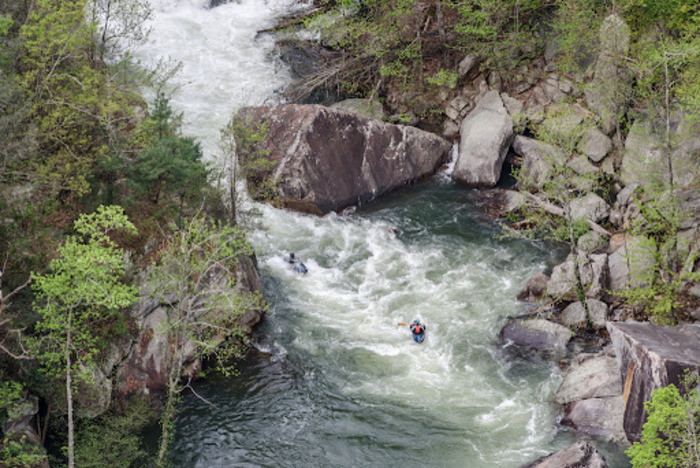
Setting Up a Float Journey on the Toccoa River
Organizing a float journey on the Toccoa River is the ultimate way to experience the beauty and tranquility of North Georgia’s waters. Before you embark on your adventure, ensure you’re aware of the local weather conditions and water levels, as these can greatly affect your journey. When planning your trip, consider renting a boat or canoe from a local outfitter to ensure you have everything you need for a successful fishing trip.
Remember, the upper part of the Toccoa River is known for its calm waters and is suitable for beginners. However, the lower part, downstream from the Blue Ridge Dam, can be more challenging due to rapid currents. Therefore, it’s advised to select a part of the river that matches your skill level.
Read more: Trout Fishing on the White River in Arkansas: Angling Tips and Tricks
Local Regulations and Fishing Etiquette
Being aware of local regulations and fishing etiquette is crucial to ensure a respectful and enjoyable fishing experience on the Toccoa River. Always respect private property and only fish in designated public areas or with proper permission.
When it comes to preserving the fishery, practice catch and release. This practice helps maintain the trout populations in the river ecosystem. Avoid removing fish from the water whenever possible, and gently release them back into the river to ensure their survival.
Moreover, it’s important to follow the local regulations set by the Georgia Department of Natural Resources. Ensure you have a valid Georgia fishing license and a trout stamp if you plan to fish for trout species. Also, make sure to follow the specific fishing seasons and regulations for the Toccoa River.
Lastly, remember to leave no trace. Pick up after yourself and respect the natural beauty of the river and its surrounding environment. This way, we can ensure that future generations can also enjoy the wonders of fly fishing on the Toccoa River.
FAQs
Q: What are some popular fly patterns for trout fishing on the Toccoa River?
A: Some popular fly patterns for Toccoa River trout fishing include Sulphur patterns, streamers, and nymphs such as Pheasant Tails and Hare’s Ears.
Q: Where can I find stocked trout in the Toccoa River?
A: This trout can be found in the Toccoa River near locations such as Curtis Switch Park, Horseshoe Bend Park, and the Toccoa River Tailwater.
Q: Can I find wild trout in the Toccoa River?
A: Yes, the Toccoa River is home to native trout as well as stocked trout, providing opportunities for anglers to catch both wild and stocked fish.
Q: What are the regulations for fishing on the Toccoa River?
A: Fishing regulations include catch-and-release fishing in certain areas, and anglers are advised to check the Georgia Department of Natural Resources website for specific rules and regulations.
Q: Are there opportunities for wade fishing on the Toccoa River?
A: Yes, there are several areas along the Toccoa River where anglers can enjoy wade fishing, offering a more immersive experience in the river’s natural surroundings.
Q: Where is the best public access for trout fishing on the Toccoa River?
A: Public access points are available at Curtis Switch Park, Horseshoe Bend Park, and other locations along the Toccoa River, providing convenient entry points for anglers.
Q: What other fish species can be found in the Toccoa River?
A: In addition to trout, the Toccoa River is home to smallmouth bass, walleye, and other species, offering diverse fishing opportunities for anglers.
Q: How can I get the best fishing experience on the Toccoa River?
A: Anglers looking for the best fishing experience on the Toccoa River should consider hiring a local guide who is familiar with the river’s features and can provide valuable insights and tips.
Q: What are the best areas for trout fishing on the Toccoa River?
A: Areas such as the Toccoa Tailwater, tributary streams, and the main stem of the river near Suches and Coopers Creek are known for offering excellent trout fishing opportunities.
Q: What are the best times of day for trout fishing on the Toccoa River?
A: Fishing during the early morning or late evening can often yield the best results, as these times coincide with periods of increased trout activity in the river.

